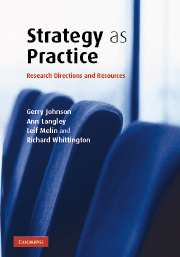Book contents
- Frontmatter
- Contents
- List of Figures
- Preface
- Authors' biographies
- Acknowledgements
- Part I
- Part II Illustrative papers
- 4 Technology as an occasion for structuring: evidence from observations of CT scanners and the social order of radiology departments
- 5 Making fast strategic decisions in high-velocity environments
- 6 In search of rationality: the purposes behind the use of formal analysis in organizations
- 7 Sensemaking and sensegiving in strategic change initiation
- 8 Business planning as pedagogy: language and control in a changing institutional field
- 9 Strategizing as lived experience and strategists' everyday efforts to shape strategic direction
- 10 Organizational restructuring and middle manager sensemaking
- 11 From metaphor to practice in the crafting of strategy
- Part III
- References
- Index
11 - From metaphor to practice in the crafting of strategy
Published online by Cambridge University Press: 10 March 2010
- Frontmatter
- Contents
- List of Figures
- Preface
- Authors' biographies
- Acknowledgements
- Part I
- Part II Illustrative papers
- 4 Technology as an occasion for structuring: evidence from observations of CT scanners and the social order of radiology departments
- 5 Making fast strategic decisions in high-velocity environments
- 6 In search of rationality: the purposes behind the use of formal analysis in organizations
- 7 Sensemaking and sensegiving in strategic change initiation
- 8 Business planning as pedagogy: language and control in a changing institutional field
- 9 Strategizing as lived experience and strategists' everyday efforts to shape strategic direction
- 10 Organizational restructuring and middle manager sensemaking
- 11 From metaphor to practice in the crafting of strategy
- Part III
- References
- Index
Summary
Abstract
This article explores how the link between the hand and the mind might be exploited in the making of strategy. Using Mintzberg's image of a potter undergoing iterative and recursive learning and knowledge-building processes as a point of departure, the authors develop a three-level theoretical schema, progressing from the physiological to the psychological to the social to trace the consequences of the hand–mind link. To illustrate their theoretical schema, the authors present an illustration case of managers from a large telecommunications firm experimenting with a process for strategy making in which they actively use their hands to construct representations of their organization and its environment. The authors conclude that new and potent forms of strategy making might be attained if the fundamental human experience of using one's hands is put in the service of all kinds of organizational learning.
Editors' introduction
This paper is an unusual action research study of a semi-consultancy intervention in the strategy making of a large mobile phone company, Orange. The authors are themselves the leaders of the intervention, though they do not describe themselves as consultants. The paper is noteworthy both for the intimacy of the empirical insight into strategy making in practice and for its sophisticated theorization of a strategy tool, the Lego Serious Play technique. The paper also provides an opportunity to reflect on the opportunities and constraints of action research.
The authors' starting point is Henry Mintzberg's (1987) famous metaphor of the potter at the wheel to characterize the hands-on crafting process of strategy making. While Mintzberg used the crafting metaphor to marginalize formal strategy, the authors carry forward its implications into the reality of deliberate strategizing.
Information
- Type
- Chapter
- Information
- Strategy as PracticeResearch Directions and Resources, pp. 197 - 204Publisher: Cambridge University PressPrint publication year: 2007
